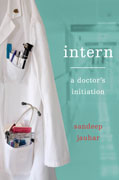Sandeep Jauhar and his family left New Delhi when he was eight years old and moved to the United States. They lived in Kentucky for a few years and then settled in southern California. Jauhar went deep enough into the study of physics at Berkeley to earn a PhD –and then settled instead on medicine. Intern: A Doctor’s Initiation is the unsettling account of his medical residency at a New York hospital, largely focused on the first year, his internship.
The use of the word “initiation” in the book’s subtitle is multifaceted. Medical residency, the apprenticeship that newly minted physicians undertake after medical school and licensure, is not merely an entrée into the profession; it is akin to being initiated into a fraternity. “This introduction to the profession is a legendarily brutal year,” Jauhar writes near the beginning of the book, “for many doctors, the most trying of their professional lives. Working 80 or more hours per week and staying up every fourth night or so on call, most spend it in a state of perpetual exhaustion, as near ascetics with regard to family, friends, food, sex, and other pleasures.”
This practice has traditionally been justified in two ways. Rationally, it is argued that physicians ultimately benefit from a brutal trial by fire. It is a commonplace that medical education typically begins when medical school ends. More viscerally, tradition is tradition; there is a deeply engrained feeling among older doctors that “if I did it, you should do it.” As with the hazing rituals of university fraternities, both rituals kill on occasion and both have been resistant to legal changes aimed at making them safer. Laws may change; practice often does not. University hazing, of course, takes the life of the odd initiate; the exhaustion of the medical intern kills patients.
Intern gives us Jauhar’s take on his internship, interweaving that experience with something of his childhood, family history, previous studies and work experiences. In the process, Jauhar tells us about himself and also about medical education and health care. For most of the book, Jauhar is critical of both the process and the result, the perceived desensitization of doctors. In the end, though, he more or less pronounces it a success.
Born to Be a Doctor?
Indian physicians and physicians of Indian ancestry have become such a common feature of the American medical landscape as to be unremarkable. That presence is increasingly reflected in the American media as well: New Delhi-born and U.S. raised, Sanjay Gupta is Cable News Network’s chief medical correspondent, the face and voice of practical health advice for millions of Americans. Atul Gawande practices medicine, serves on the faculty of the Harvard Medical School, and writes about his experiences and observations in The New Yorker magazine — work so far woven into and collected into two fine books. Jauhar sketches a physician-rich milieu: His maternal grandfather was a doctor, his brother is a doctor, he marries a doctor, and his father-in-law is a doctor. These facts give him an intimate and sometimes jaundiced view of the profession.
This may be part of what makes Jauhar frank about both his own failings and the broader failings of his profession. He has journalistic roots in common with Gupta and Gawande as well, and has aired his concerns about medical education and practice over a period of more than 10 years now, working as a journalist from the time he began studying medicine.
One of the book’s prominent strengths is its apparent openness: The story we get is “warts and all.” Rather than a whitewashed memoir — a pristine family, dedicated son, proud physician, noble profession, inevitable triumph — we get some of the messier and more interesting and intimate details. Jauhar’s father, a plant geneticist with a PhD, is described as “embittered and rigid and in a constant state of conflict with professional colleagues.” Angry about not attaining a tenured position — which he largely ascribes to American racism — he encourages his son to pursue medicine, lauding the profession while disdaining practitioners. “He thought they were all crooks,” Jauhar tells us. He describes his mother in similarly un-romanticized terms. “She was a typical Indian mother, loving, caring, committed, but small-minded, too, in that only-concerned-with-my-own-backyard way. She had struggled alongside my father, raising the three of us kids, working fulltime as a lab tech, making do with much less than she was accustomed to having, sacrificing so my father could write his academic textbooks, which sold a few dozen copies a year.”
The saving grace is that Jauhar is open about his own fumblings and failings as well. The book tells the story not of the classic clean — if fatiguing — arc of internship but of his struggles with both physical injury and emotional distress as he works through his apprenticeship. He doesn’t play any of this for sympathy, either. It is mostly after the fact that he names one of the central problems: depression.
Failure of Medical Ethics
Jauhar’s prose can tend toward the purple, but there are regular bits and pieces of poetry woven into his descriptions. He also demonstrates an appealing willingness to leaven or puncture sections that threaten to list too far toward greeting card poetry, at the expense of his own dignity. “The air was thick and still,” he writes in one such riff. “On the sidewalk, blooming tulips rose out of the gated tree plots like hands coming out of a grave. I took off my coat and swung it over my shoulder. Its contents spilled all over the sidewalk.”
The facts and the organization of the book are more problematic. Jauhar is looking back on his internship from more than a decade’s distance — though some sections of the book were previously published as articles in the New York Times, The New England Journal of Medicine and The Lancet. In one of the prefatory sections he notes that “in some places, time has been compressed or the order of events has been changed for the sake of narrative cohesion; and in rare cases I have used composite sketches to better represent my experience.”
Is this journalistic or scholarly analysis of medical education? Is it memoir? Is it fiction — with the occasional poetic edge? It is all of the above, which can be an admirable and powerful amalgam. But here the seams show. Some responsibility lies with the editing, or failures thereof. In places, the problems are as trivial as the misapplication of a word here and there that pauses the reader, causing momentary confusion. A bedside picture of “a well-to-do businessman” in steep medical decline shows him “looking every bit the Connecticut waterman he once was.” But one has to think Jauhar means here something closer to “yachtsman.” In New York or New England, “waterman” would refer to a river worker; further south along the eastern seaboard, “waterman” would refer to someone in the shellfish industry.
In other places, the lapses have more to do with emphasis and continuity. Early on, we are told of Lisa, Jauhar’s girlfriend at Berkeley. She is diagnosed with the devastating autoimmune disorder lupus and we see him “whispering that one day she was going to be cured and that I would see her through it. She cried hard that day,” he tells us, “and so did I. For her and for myself.” That’s just about all we get of Lisa, who appears to have been something of his motivation for switching to medicine from physics. Did she die? That isn’t clear. If not, how and why did they part? She pops up again some 150 pages later. “In a flash, I thought of Lisa, wondering how she was doing.” And then she vanishes again, this time with finality, still incompletely explained.
The most serious failures, however, relate to facts. That there wasn’t sufficient fact-checking done to catch these errors during the publication process mars Jauhar’s credibility, which is a particularly valuable asset when working in a less traditional form.
In the latter third of the book, for example, Jauhar makes a passing reference to the Tuskegee syphilis experiments, writing in part that, “in the 1940s … black men with syphilis were intentionally left untreated, despite the availability of penicillin, in order to study that disease’s complications.” The Tuskegee experiments are notorious in the American medical community in general, and among the African-American population with particular intensity, feeding contemporary medical conspiracy theories such as the one that views AIDS as a government plot against blacks. The reference is a powerful touchstone of failure in medical ethics. But a crucial part of what Jauhar relates here is wrong and another part is missing. The Tuskegee experiments began in 1932; penicillin was not widely available to the civilian population of the U.S. until the end of the Second World War. But the true horror of the experiment was that it ran a full four decades and didn’t end until the early 1970s.
Elephant in the Emergency Room
Still, we benefit, here and elsewhere, from Jauhar’s keen eye and his willingness to explore and discuss things from all angles. But what of the pitfalls in the current model of medical training? In many ways, that’s the elephant in the emergency (or hospital) room: In 2000, the Institute of Medicine, in Washington, D.C., estimated the annual toll from medical errors at between 48,000 and 98,000 deaths; it is broadly accepted that overburdened and fatigued interns are disproportionately responsible. The focus of Jauhar’s book makes it an ideal venue in which to explore the systems, management and HR issues that undergird this problem. For the most part, however, he does not do so; in the end, what he gives us is personal.
He does cite the famous 1984 death of Libby Zion. The eighteen-year-old daughter of Sidney Zion — a lawyer, once Assistant U.S. Attorney for New Jersey, who (like Jauhar) turned New York City writer — Libby died of cardiac arrest after eight hours in a New York emergency room. Her death resulted in a number of changes in New York law regarding the working conditions for medical residents. For example, as of 1987, Jauhar recounts, “residents were prohibited from working more than twenty-four hours at a stretch or more than eighty hours per week.” Eventually, he tells us, these guidelines became more or less national. But they have not been effectively enforced.
In response to the 2000 study cited above, the Accreditation Council for Graduate Medical Education (ACGME) again revised the number of hours interns should be allowed to work. But these guidelines look worse, not better, than the 1987 guidelines: Up to nine times per month, interns can be required to work as long as 30 consecutive hours — and, according to the September 2006 issue of the Journal of the American Medical Association, more than 80% of medical interns subsequently surveyed reported that they were still working beyond those guidelines.
Given the seriousness of the problem, why has this not been more effectively addressed? Jauhar discusses the issue glancingly. In response to the 1987 regulations, he writes, “Teaching hospitals that had relied on interns and residents as medical staff were forced to grapple with the problem of cross-coverage: providing care to patients when their primary resident was not on duty.” He writes this in introducing his own rotation as a “night float,” one of the staffing changes meant to address part of this problem. But he quickly moves off any discussion of solutions.
“In the end,” he writes in the book’s closing pages, “I adapted to the culture around me. I came to accept the workings of the hospital and of my colleagues. I became less judgmental — of doctors, not patients (there was a time when it was the other way around) — and more forgiving of, more faithful to, my guild.”
That’s fair. It is clear-eyed and more honest than most people are willing to be in a public forum.



